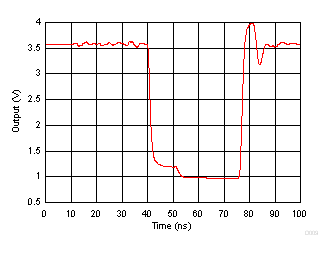JAJU648A November 2018 – April 2022 TLV3601 , TLV3601-Q1 , TLV3603 , TLV3603-Q1
- 概要
- Resources
- 特長
- アプリケーション
- 5
- 1System Description
- 2System Overview
- 3Hardware, Software, Testing Requirements, and Test Results
- 4Design Files
- 5Related Documentation
- 6About the Author
- 7Revision History
3.2.2.1.1.4 Overdriven Response
Figure 3-7 shows the pulse response of the OPA858 without an optical attenuator in the signal path. In this condition, the amplifier output is saturated and extends the 20-ns input pulse to a measured pulse width of 36 ns and increases the fall time to 1.5 ns compared to the non-saturated graph in Figure 3-4. The pulse extension does not affect this design because the measurement is triggered on the falling edge, but the fall time can potentially add an error as discussed further in Section 3.2.2.1.2. The plot in Figure 3-7 also shows the maximum achievable signal swing of 2.6 V when measured from the bias set in the design.
 Figure 3-7 OPA858 Overdriven Response
Figure 3-7 OPA858 Overdriven Response